LST5CCL Company & Commercial Law: Partnership, Liability & Negligence
VerifiedAdded on 2023/06/11
|11
|3153
|139
Case Study
AI Summary
This case study delves into the intricacies of partnership law, focusing on scenarios involving negligence and liability within a business context. It analyzes the formation of a partnership between Julio, Carolyn, and Trisha, determining their status as partners while distinguishing Sarah as a creditor. The analysis extends to the potential liability of Julio and his partners to X for negligent misrepresentation regarding tax advice, evaluating whether Julio breached his duty of care. Furthermore, the case examines the liability of Julio and other partners to Y, considering the elements necessary to establish negligent misrepresentation and the extent to which partners can be held jointly and severally liable. The arguments are supported by relevant case law and statutory provisions, providing a comprehensive legal analysis of the issues. Desklib offers this solution along with a wealth of study resources, including past papers and solved assignments, to aid students in their academic pursuits.

Company and Commercial Law
Paraphrase This Document
Need a fresh take? Get an instant paraphrase of this document with our AI Paraphraser
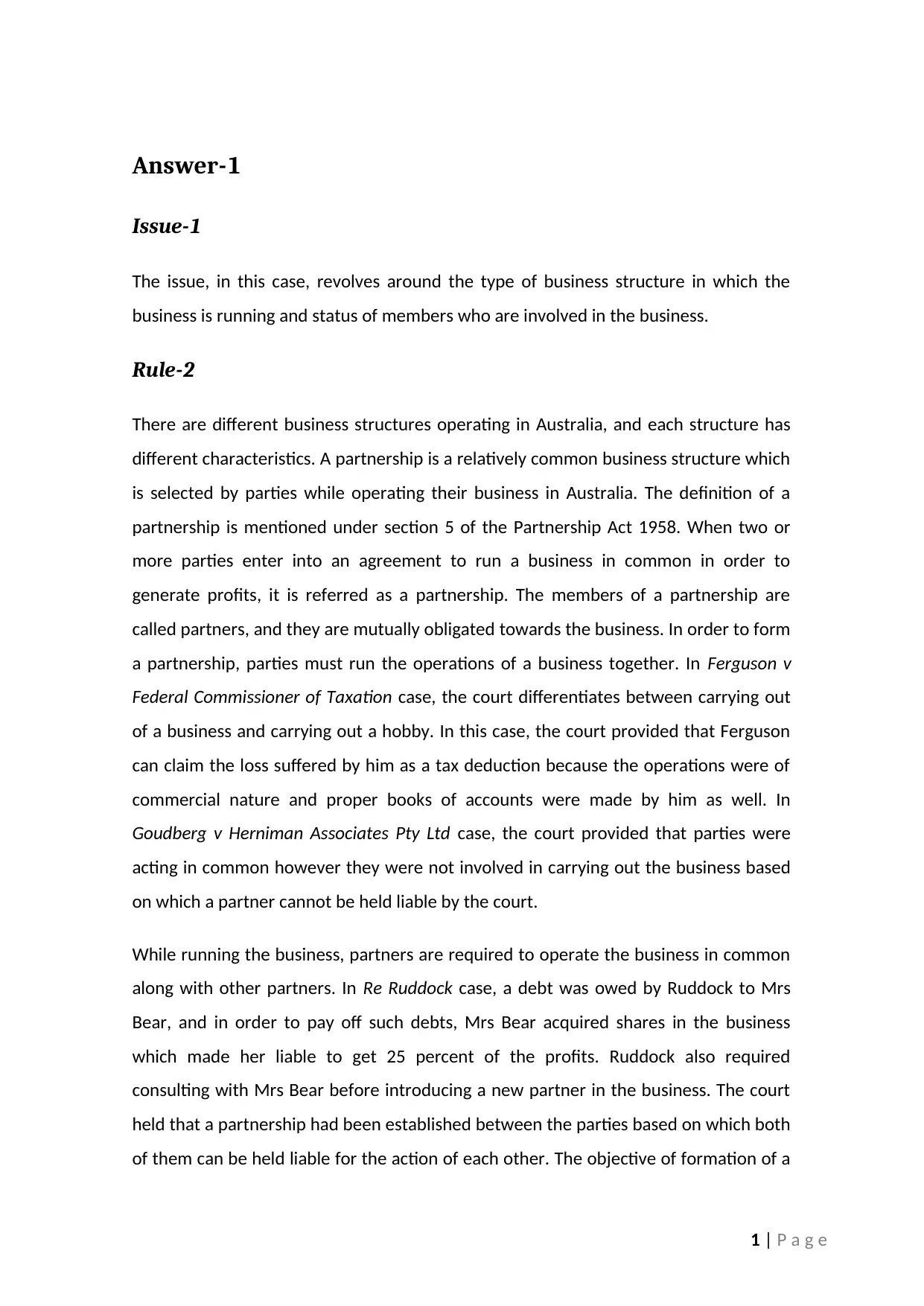
Answer-1
Issue-1
The issue, in this case, revolves around the type of business structure in which the
business is running and status of members who are involved in the business.
Rule-2
There are different business structures operating in Australia, and each structure has
different characteristics. A partnership is a relatively common business structure which
is selected by parties while operating their business in Australia. The definition of a
partnership is mentioned under section 5 of the Partnership Act 1958. When two or
more parties enter into an agreement to run a business in common in order to
generate profits, it is referred as a partnership. The members of a partnership are
called partners, and they are mutually obligated towards the business. In order to form
a partnership, parties must run the operations of a business together. In Ferguson v
Federal Commissioner of Taxation case, the court differentiates between carrying out
of a business and carrying out a hobby. In this case, the court provided that Ferguson
can claim the loss suffered by him as a tax deduction because the operations were of
commercial nature and proper books of accounts were made by him as well. In
Goudberg v Herniman Associates Pty Ltd case, the court provided that parties were
acting in common however they were not involved in carrying out the business based
on which a partner cannot be held liable by the court.
While running the business, partners are required to operate the business in common
along with other partners. In Re Ruddock case, a debt was owed by Ruddock to Mrs
Bear, and in order to pay off such debts, Mrs Bear acquired shares in the business
which made her liable to get 25 percent of the profits. Ruddock also required
consulting with Mrs Bear before introducing a new partner in the business. The court
held that a partnership had been established between the parties based on which both
of them can be held liable for the action of each other. The objective of formation of a
1 | P a g e
Issue-1
The issue, in this case, revolves around the type of business structure in which the
business is running and status of members who are involved in the business.
Rule-2
There are different business structures operating in Australia, and each structure has
different characteristics. A partnership is a relatively common business structure which
is selected by parties while operating their business in Australia. The definition of a
partnership is mentioned under section 5 of the Partnership Act 1958. When two or
more parties enter into an agreement to run a business in common in order to
generate profits, it is referred as a partnership. The members of a partnership are
called partners, and they are mutually obligated towards the business. In order to form
a partnership, parties must run the operations of a business together. In Ferguson v
Federal Commissioner of Taxation case, the court differentiates between carrying out
of a business and carrying out a hobby. In this case, the court provided that Ferguson
can claim the loss suffered by him as a tax deduction because the operations were of
commercial nature and proper books of accounts were made by him as well. In
Goudberg v Herniman Associates Pty Ltd case, the court provided that parties were
acting in common however they were not involved in carrying out the business based
on which a partner cannot be held liable by the court.
While running the business, partners are required to operate the business in common
along with other partners. In Re Ruddock case, a debt was owed by Ruddock to Mrs
Bear, and in order to pay off such debts, Mrs Bear acquired shares in the business
which made her liable to get 25 percent of the profits. Ruddock also required
consulting with Mrs Bear before introducing a new partner in the business. The court
held that a partnership had been established between the parties based on which both
of them can be held liable for the action of each other. The objective of formation of a
1 | P a g e
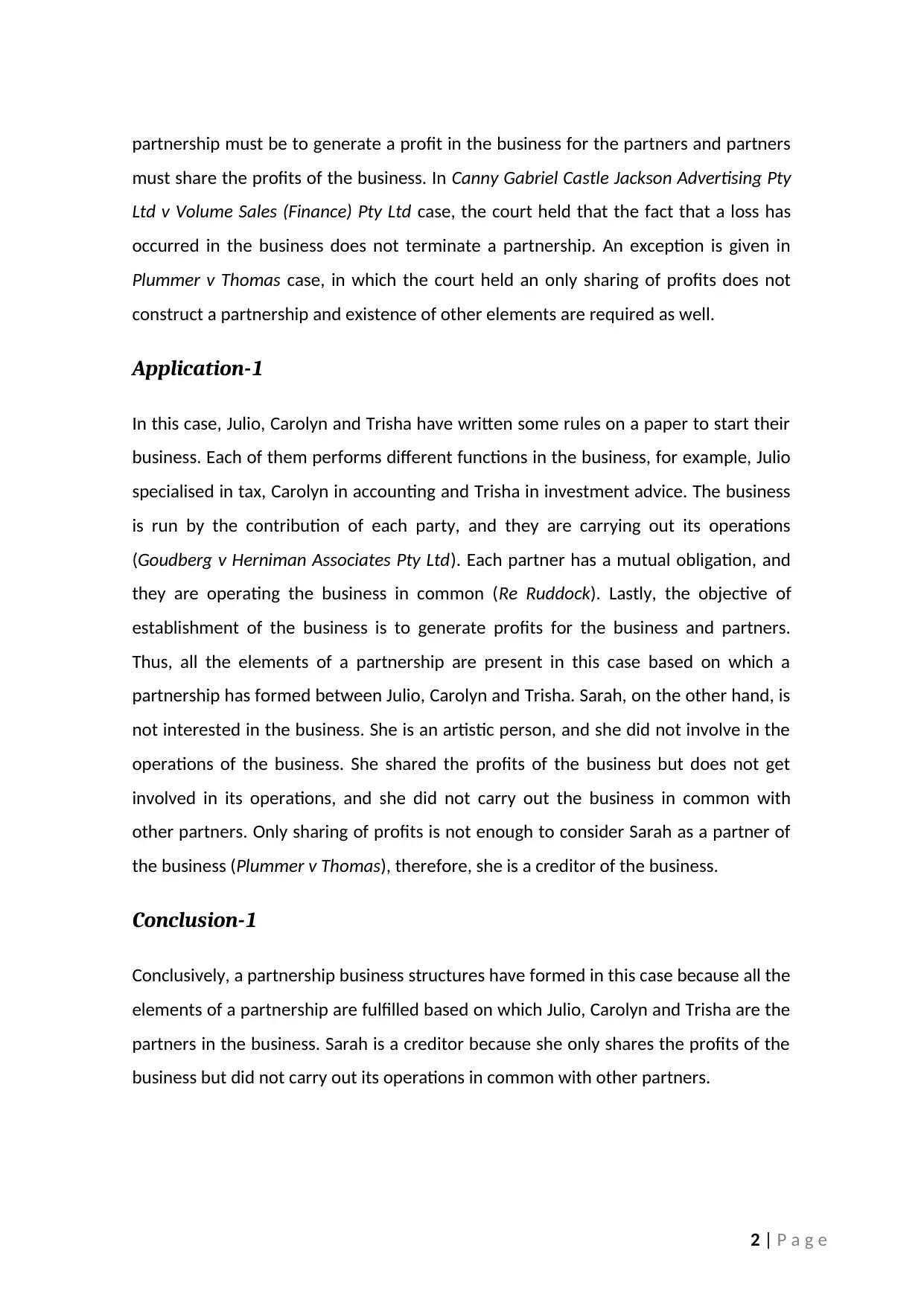
partnership must be to generate a profit in the business for the partners and partners
must share the profits of the business. In Canny Gabriel Castle Jackson Advertising Pty
Ltd v Volume Sales (Finance) Pty Ltd case, the court held that the fact that a loss has
occurred in the business does not terminate a partnership. An exception is given in
Plummer v Thomas case, in which the court held an only sharing of profits does not
construct a partnership and existence of other elements are required as well.
Application-1
In this case, Julio, Carolyn and Trisha have written some rules on a paper to start their
business. Each of them performs different functions in the business, for example, Julio
specialised in tax, Carolyn in accounting and Trisha in investment advice. The business
is run by the contribution of each party, and they are carrying out its operations
(Goudberg v Herniman Associates Pty Ltd). Each partner has a mutual obligation, and
they are operating the business in common (Re Ruddock). Lastly, the objective of
establishment of the business is to generate profits for the business and partners.
Thus, all the elements of a partnership are present in this case based on which a
partnership has formed between Julio, Carolyn and Trisha. Sarah, on the other hand, is
not interested in the business. She is an artistic person, and she did not involve in the
operations of the business. She shared the profits of the business but does not get
involved in its operations, and she did not carry out the business in common with
other partners. Only sharing of profits is not enough to consider Sarah as a partner of
the business (Plummer v Thomas), therefore, she is a creditor of the business.
Conclusion-1
Conclusively, a partnership business structures have formed in this case because all the
elements of a partnership are fulfilled based on which Julio, Carolyn and Trisha are the
partners in the business. Sarah is a creditor because she only shares the profits of the
business but did not carry out its operations in common with other partners.
2 | P a g e
must share the profits of the business. In Canny Gabriel Castle Jackson Advertising Pty
Ltd v Volume Sales (Finance) Pty Ltd case, the court held that the fact that a loss has
occurred in the business does not terminate a partnership. An exception is given in
Plummer v Thomas case, in which the court held an only sharing of profits does not
construct a partnership and existence of other elements are required as well.
Application-1
In this case, Julio, Carolyn and Trisha have written some rules on a paper to start their
business. Each of them performs different functions in the business, for example, Julio
specialised in tax, Carolyn in accounting and Trisha in investment advice. The business
is run by the contribution of each party, and they are carrying out its operations
(Goudberg v Herniman Associates Pty Ltd). Each partner has a mutual obligation, and
they are operating the business in common (Re Ruddock). Lastly, the objective of
establishment of the business is to generate profits for the business and partners.
Thus, all the elements of a partnership are present in this case based on which a
partnership has formed between Julio, Carolyn and Trisha. Sarah, on the other hand, is
not interested in the business. She is an artistic person, and she did not involve in the
operations of the business. She shared the profits of the business but does not get
involved in its operations, and she did not carry out the business in common with
other partners. Only sharing of profits is not enough to consider Sarah as a partner of
the business (Plummer v Thomas), therefore, she is a creditor of the business.
Conclusion-1
Conclusively, a partnership business structures have formed in this case because all the
elements of a partnership are fulfilled based on which Julio, Carolyn and Trisha are the
partners in the business. Sarah is a creditor because she only shares the profits of the
business but did not carry out its operations in common with other partners.
2 | P a g e
⊘ This is a preview!⊘
Do you want full access?
Subscribe today to unlock all pages.

Trusted by 1+ million students worldwide
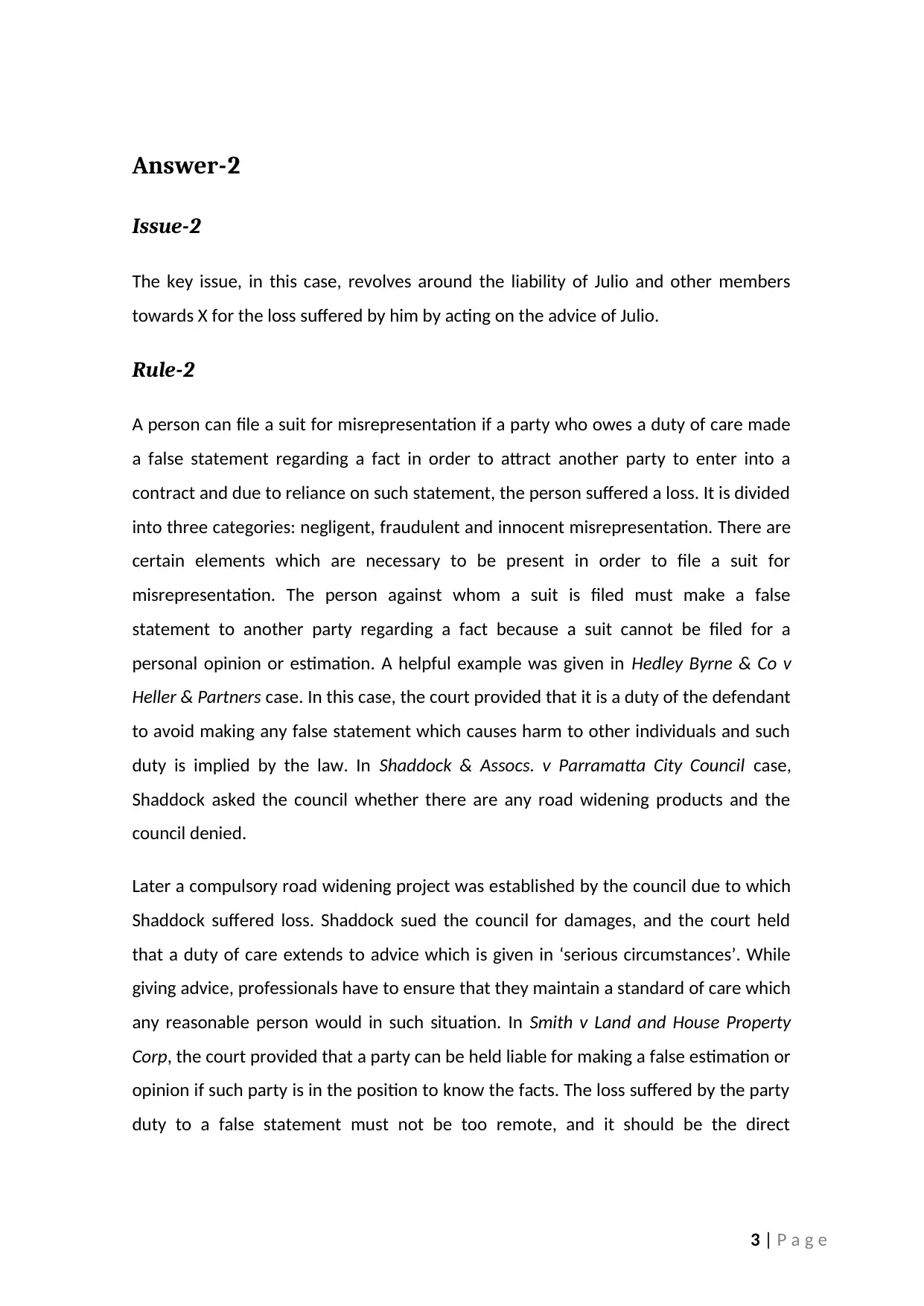
Answer-2
Issue-2
The key issue, in this case, revolves around the liability of Julio and other members
towards X for the loss suffered by him by acting on the advice of Julio.
Rule-2
A person can file a suit for misrepresentation if a party who owes a duty of care made
a false statement regarding a fact in order to attract another party to enter into a
contract and due to reliance on such statement, the person suffered a loss. It is divided
into three categories: negligent, fraudulent and innocent misrepresentation. There are
certain elements which are necessary to be present in order to file a suit for
misrepresentation. The person against whom a suit is filed must make a false
statement to another party regarding a fact because a suit cannot be filed for a
personal opinion or estimation. A helpful example was given in Hedley Byrne & Co v
Heller & Partners case. In this case, the court provided that it is a duty of the defendant
to avoid making any false statement which causes harm to other individuals and such
duty is implied by the law. In Shaddock & Assocs. v Parramatta City Council case,
Shaddock asked the council whether there are any road widening products and the
council denied.
Later a compulsory road widening project was established by the council due to which
Shaddock suffered loss. Shaddock sued the council for damages, and the court held
that a duty of care extends to advice which is given in ‘serious circumstances’. While
giving advice, professionals have to ensure that they maintain a standard of care which
any reasonable person would in such situation. In Smith v Land and House Property
Corp, the court provided that a party can be held liable for making a false estimation or
opinion if such party is in the position to know the facts. The loss suffered by the party
duty to a false statement must not be too remote, and it should be the direct
3 | P a g e
Issue-2
The key issue, in this case, revolves around the liability of Julio and other members
towards X for the loss suffered by him by acting on the advice of Julio.
Rule-2
A person can file a suit for misrepresentation if a party who owes a duty of care made
a false statement regarding a fact in order to attract another party to enter into a
contract and due to reliance on such statement, the person suffered a loss. It is divided
into three categories: negligent, fraudulent and innocent misrepresentation. There are
certain elements which are necessary to be present in order to file a suit for
misrepresentation. The person against whom a suit is filed must make a false
statement to another party regarding a fact because a suit cannot be filed for a
personal opinion or estimation. A helpful example was given in Hedley Byrne & Co v
Heller & Partners case. In this case, the court provided that it is a duty of the defendant
to avoid making any false statement which causes harm to other individuals and such
duty is implied by the law. In Shaddock & Assocs. v Parramatta City Council case,
Shaddock asked the council whether there are any road widening products and the
council denied.
Later a compulsory road widening project was established by the council due to which
Shaddock suffered loss. Shaddock sued the council for damages, and the court held
that a duty of care extends to advice which is given in ‘serious circumstances’. While
giving advice, professionals have to ensure that they maintain a standard of care which
any reasonable person would in such situation. In Smith v Land and House Property
Corp, the court provided that a party can be held liable for making a false estimation or
opinion if such party is in the position to know the facts. The loss suffered by the party
duty to a false statement must not be too remote, and it should be the direct
3 | P a g e
Paraphrase This Document
Need a fresh take? Get an instant paraphrase of this document with our AI Paraphraser
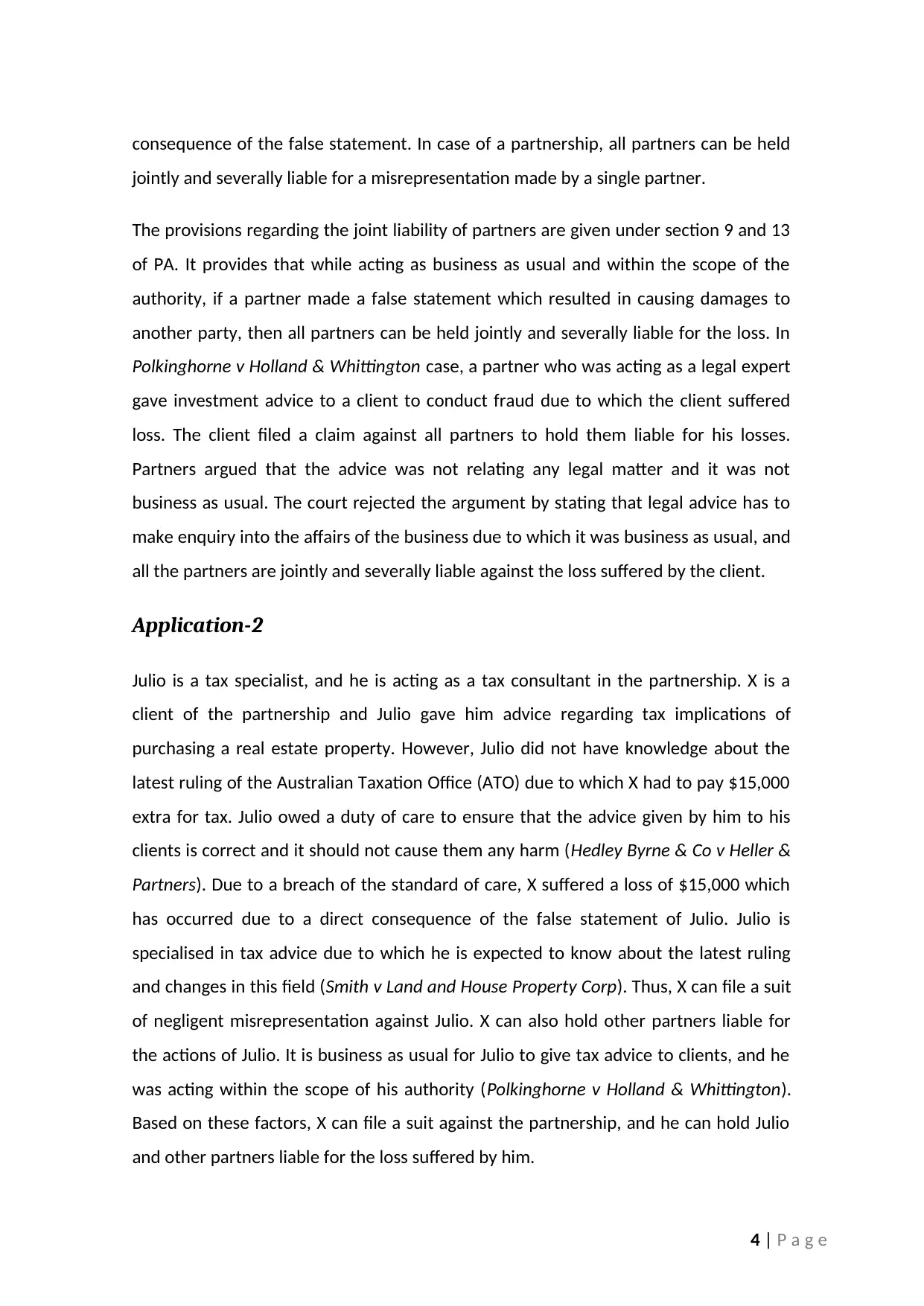
consequence of the false statement. In case of a partnership, all partners can be held
jointly and severally liable for a misrepresentation made by a single partner.
The provisions regarding the joint liability of partners are given under section 9 and 13
of PA. It provides that while acting as business as usual and within the scope of the
authority, if a partner made a false statement which resulted in causing damages to
another party, then all partners can be held jointly and severally liable for the loss. In
Polkinghorne v Holland & Whittington case, a partner who was acting as a legal expert
gave investment advice to a client to conduct fraud due to which the client suffered
loss. The client filed a claim against all partners to hold them liable for his losses.
Partners argued that the advice was not relating any legal matter and it was not
business as usual. The court rejected the argument by stating that legal advice has to
make enquiry into the affairs of the business due to which it was business as usual, and
all the partners are jointly and severally liable against the loss suffered by the client.
Application-2
Julio is a tax specialist, and he is acting as a tax consultant in the partnership. X is a
client of the partnership and Julio gave him advice regarding tax implications of
purchasing a real estate property. However, Julio did not have knowledge about the
latest ruling of the Australian Taxation Office (ATO) due to which X had to pay $15,000
extra for tax. Julio owed a duty of care to ensure that the advice given by him to his
clients is correct and it should not cause them any harm (Hedley Byrne & Co v Heller &
Partners). Due to a breach of the standard of care, X suffered a loss of $15,000 which
has occurred due to a direct consequence of the false statement of Julio. Julio is
specialised in tax advice due to which he is expected to know about the latest ruling
and changes in this field (Smith v Land and House Property Corp). Thus, X can file a suit
of negligent misrepresentation against Julio. X can also hold other partners liable for
the actions of Julio. It is business as usual for Julio to give tax advice to clients, and he
was acting within the scope of his authority (Polkinghorne v Holland & Whittington).
Based on these factors, X can file a suit against the partnership, and he can hold Julio
and other partners liable for the loss suffered by him.
4 | P a g e
jointly and severally liable for a misrepresentation made by a single partner.
The provisions regarding the joint liability of partners are given under section 9 and 13
of PA. It provides that while acting as business as usual and within the scope of the
authority, if a partner made a false statement which resulted in causing damages to
another party, then all partners can be held jointly and severally liable for the loss. In
Polkinghorne v Holland & Whittington case, a partner who was acting as a legal expert
gave investment advice to a client to conduct fraud due to which the client suffered
loss. The client filed a claim against all partners to hold them liable for his losses.
Partners argued that the advice was not relating any legal matter and it was not
business as usual. The court rejected the argument by stating that legal advice has to
make enquiry into the affairs of the business due to which it was business as usual, and
all the partners are jointly and severally liable against the loss suffered by the client.
Application-2
Julio is a tax specialist, and he is acting as a tax consultant in the partnership. X is a
client of the partnership and Julio gave him advice regarding tax implications of
purchasing a real estate property. However, Julio did not have knowledge about the
latest ruling of the Australian Taxation Office (ATO) due to which X had to pay $15,000
extra for tax. Julio owed a duty of care to ensure that the advice given by him to his
clients is correct and it should not cause them any harm (Hedley Byrne & Co v Heller &
Partners). Due to a breach of the standard of care, X suffered a loss of $15,000 which
has occurred due to a direct consequence of the false statement of Julio. Julio is
specialised in tax advice due to which he is expected to know about the latest ruling
and changes in this field (Smith v Land and House Property Corp). Thus, X can file a suit
of negligent misrepresentation against Julio. X can also hold other partners liable for
the actions of Julio. It is business as usual for Julio to give tax advice to clients, and he
was acting within the scope of his authority (Polkinghorne v Holland & Whittington).
Based on these factors, X can file a suit against the partnership, and he can hold Julio
and other partners liable for the loss suffered by him.
4 | P a g e
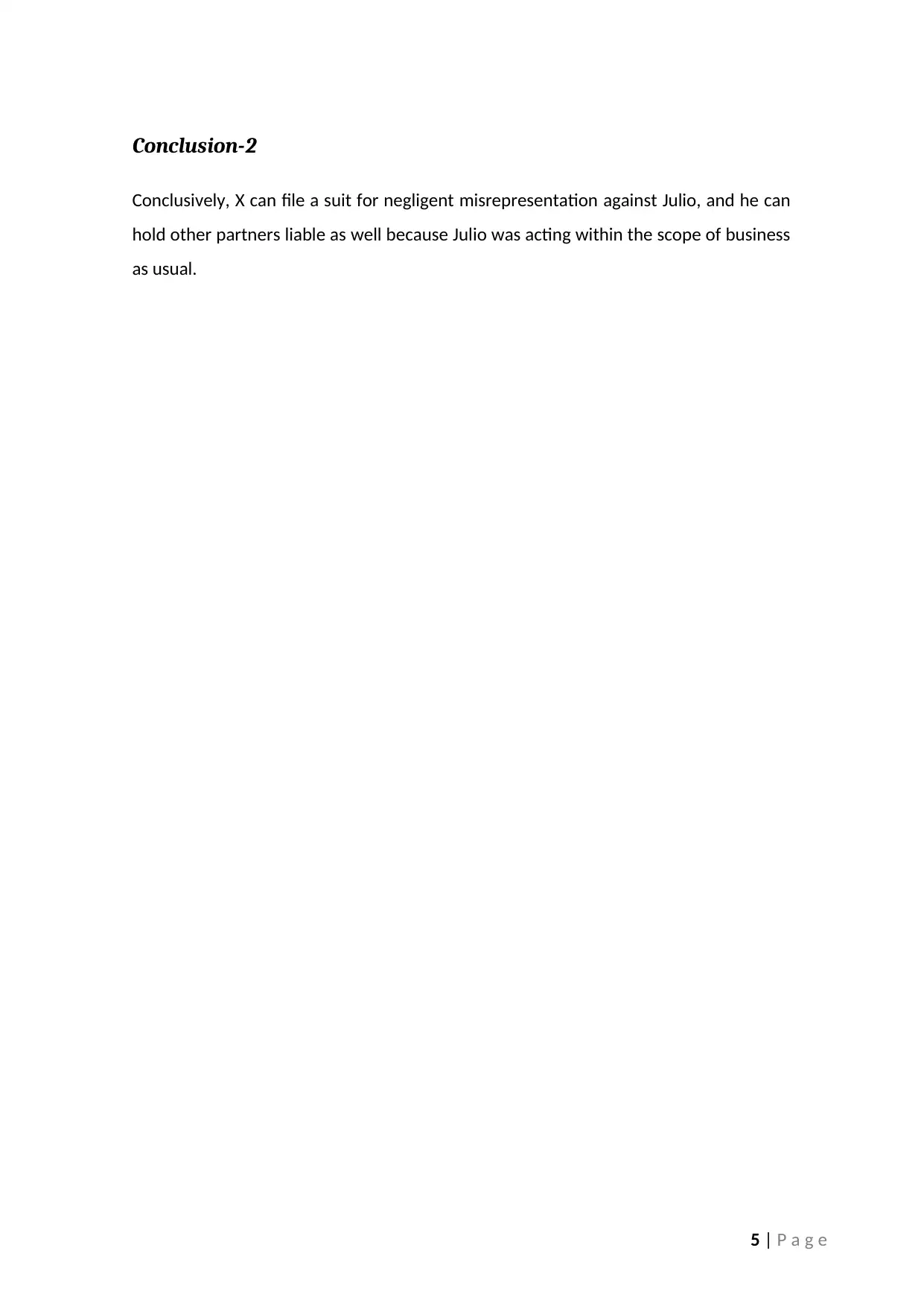
Conclusion-2
Conclusively, X can file a suit for negligent misrepresentation against Julio, and he can
hold other partners liable as well because Julio was acting within the scope of business
as usual.
5 | P a g e
Conclusively, X can file a suit for negligent misrepresentation against Julio, and he can
hold other partners liable as well because Julio was acting within the scope of business
as usual.
5 | P a g e
⊘ This is a preview!⊘
Do you want full access?
Subscribe today to unlock all pages.

Trusted by 1+ million students worldwide
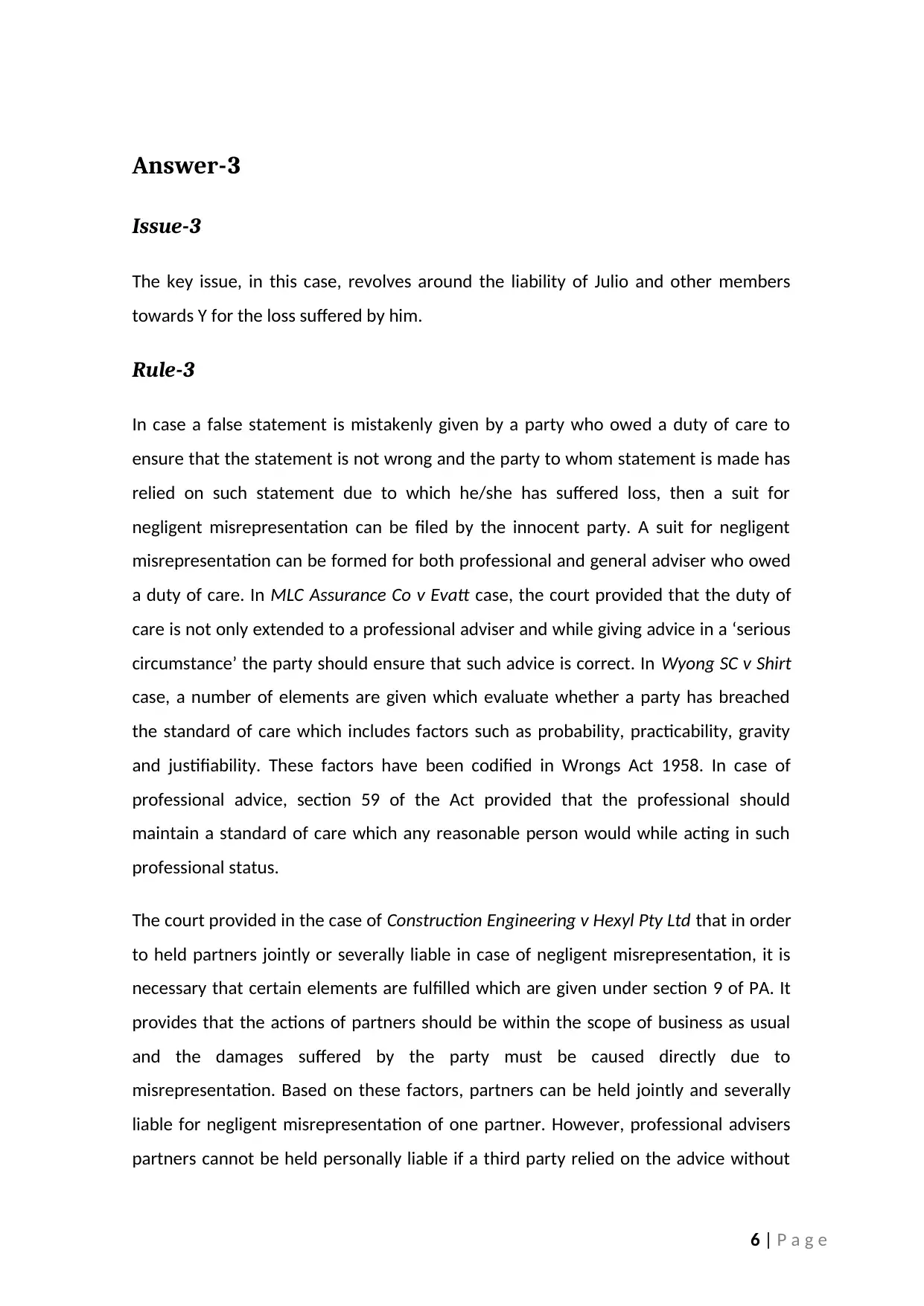
Answer-3
Issue-3
The key issue, in this case, revolves around the liability of Julio and other members
towards Y for the loss suffered by him.
Rule-3
In case a false statement is mistakenly given by a party who owed a duty of care to
ensure that the statement is not wrong and the party to whom statement is made has
relied on such statement due to which he/she has suffered loss, then a suit for
negligent misrepresentation can be filed by the innocent party. A suit for negligent
misrepresentation can be formed for both professional and general adviser who owed
a duty of care. In MLC Assurance Co v Evatt case, the court provided that the duty of
care is not only extended to a professional adviser and while giving advice in a ‘serious
circumstance’ the party should ensure that such advice is correct. In Wyong SC v Shirt
case, a number of elements are given which evaluate whether a party has breached
the standard of care which includes factors such as probability, practicability, gravity
and justifiability. These factors have been codified in Wrongs Act 1958. In case of
professional advice, section 59 of the Act provided that the professional should
maintain a standard of care which any reasonable person would while acting in such
professional status.
The court provided in the case of Construction Engineering v Hexyl Pty Ltd that in order
to held partners jointly or severally liable in case of negligent misrepresentation, it is
necessary that certain elements are fulfilled which are given under section 9 of PA. It
provides that the actions of partners should be within the scope of business as usual
and the damages suffered by the party must be caused directly due to
misrepresentation. Based on these factors, partners can be held jointly and severally
liable for negligent misrepresentation of one partner. However, professional advisers
partners cannot be held personally liable if a third party relied on the advice without
6 | P a g e
Issue-3
The key issue, in this case, revolves around the liability of Julio and other members
towards Y for the loss suffered by him.
Rule-3
In case a false statement is mistakenly given by a party who owed a duty of care to
ensure that the statement is not wrong and the party to whom statement is made has
relied on such statement due to which he/she has suffered loss, then a suit for
negligent misrepresentation can be filed by the innocent party. A suit for negligent
misrepresentation can be formed for both professional and general adviser who owed
a duty of care. In MLC Assurance Co v Evatt case, the court provided that the duty of
care is not only extended to a professional adviser and while giving advice in a ‘serious
circumstance’ the party should ensure that such advice is correct. In Wyong SC v Shirt
case, a number of elements are given which evaluate whether a party has breached
the standard of care which includes factors such as probability, practicability, gravity
and justifiability. These factors have been codified in Wrongs Act 1958. In case of
professional advice, section 59 of the Act provided that the professional should
maintain a standard of care which any reasonable person would while acting in such
professional status.
The court provided in the case of Construction Engineering v Hexyl Pty Ltd that in order
to held partners jointly or severally liable in case of negligent misrepresentation, it is
necessary that certain elements are fulfilled which are given under section 9 of PA. It
provides that the actions of partners should be within the scope of business as usual
and the damages suffered by the party must be caused directly due to
misrepresentation. Based on these factors, partners can be held jointly and severally
liable for negligent misrepresentation of one partner. However, professional advisers
partners cannot be held personally liable if a third party relied on the advice without
6 | P a g e
Paraphrase This Document
Need a fresh take? Get an instant paraphrase of this document with our AI Paraphraser
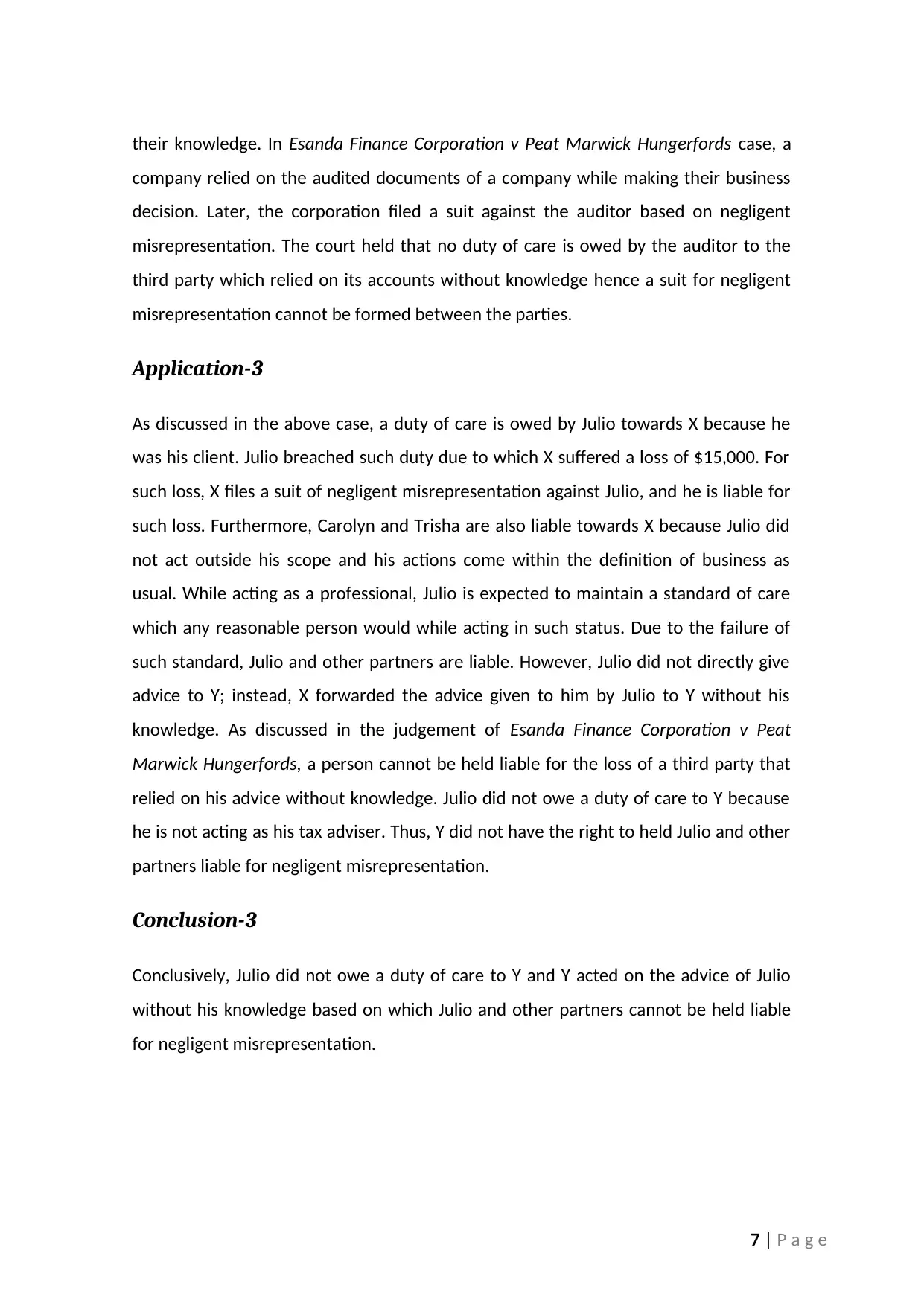
their knowledge. In Esanda Finance Corporation v Peat Marwick Hungerfords case, a
company relied on the audited documents of a company while making their business
decision. Later, the corporation filed a suit against the auditor based on negligent
misrepresentation. The court held that no duty of care is owed by the auditor to the
third party which relied on its accounts without knowledge hence a suit for negligent
misrepresentation cannot be formed between the parties.
Application-3
As discussed in the above case, a duty of care is owed by Julio towards X because he
was his client. Julio breached such duty due to which X suffered a loss of $15,000. For
such loss, X files a suit of negligent misrepresentation against Julio, and he is liable for
such loss. Furthermore, Carolyn and Trisha are also liable towards X because Julio did
not act outside his scope and his actions come within the definition of business as
usual. While acting as a professional, Julio is expected to maintain a standard of care
which any reasonable person would while acting in such status. Due to the failure of
such standard, Julio and other partners are liable. However, Julio did not directly give
advice to Y; instead, X forwarded the advice given to him by Julio to Y without his
knowledge. As discussed in the judgement of Esanda Finance Corporation v Peat
Marwick Hungerfords, a person cannot be held liable for the loss of a third party that
relied on his advice without knowledge. Julio did not owe a duty of care to Y because
he is not acting as his tax adviser. Thus, Y did not have the right to held Julio and other
partners liable for negligent misrepresentation.
Conclusion-3
Conclusively, Julio did not owe a duty of care to Y and Y acted on the advice of Julio
without his knowledge based on which Julio and other partners cannot be held liable
for negligent misrepresentation.
7 | P a g e
company relied on the audited documents of a company while making their business
decision. Later, the corporation filed a suit against the auditor based on negligent
misrepresentation. The court held that no duty of care is owed by the auditor to the
third party which relied on its accounts without knowledge hence a suit for negligent
misrepresentation cannot be formed between the parties.
Application-3
As discussed in the above case, a duty of care is owed by Julio towards X because he
was his client. Julio breached such duty due to which X suffered a loss of $15,000. For
such loss, X files a suit of negligent misrepresentation against Julio, and he is liable for
such loss. Furthermore, Carolyn and Trisha are also liable towards X because Julio did
not act outside his scope and his actions come within the definition of business as
usual. While acting as a professional, Julio is expected to maintain a standard of care
which any reasonable person would while acting in such status. Due to the failure of
such standard, Julio and other partners are liable. However, Julio did not directly give
advice to Y; instead, X forwarded the advice given to him by Julio to Y without his
knowledge. As discussed in the judgement of Esanda Finance Corporation v Peat
Marwick Hungerfords, a person cannot be held liable for the loss of a third party that
relied on his advice without knowledge. Julio did not owe a duty of care to Y because
he is not acting as his tax adviser. Thus, Y did not have the right to held Julio and other
partners liable for negligent misrepresentation.
Conclusion-3
Conclusively, Julio did not owe a duty of care to Y and Y acted on the advice of Julio
without his knowledge based on which Julio and other partners cannot be held liable
for negligent misrepresentation.
7 | P a g e
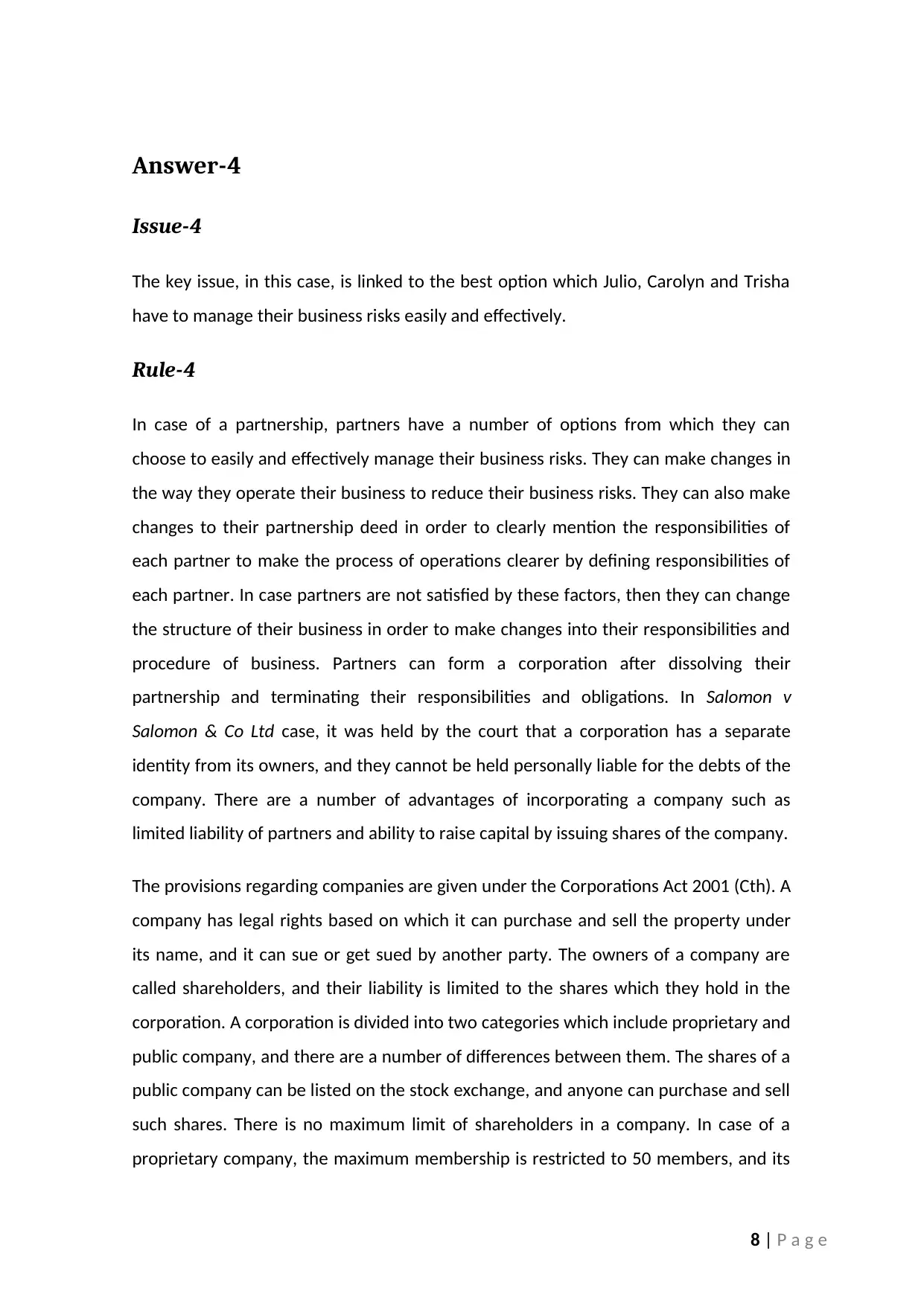
Answer-4
Issue-4
The key issue, in this case, is linked to the best option which Julio, Carolyn and Trisha
have to manage their business risks easily and effectively.
Rule-4
In case of a partnership, partners have a number of options from which they can
choose to easily and effectively manage their business risks. They can make changes in
the way they operate their business to reduce their business risks. They can also make
changes to their partnership deed in order to clearly mention the responsibilities of
each partner to make the process of operations clearer by defining responsibilities of
each partner. In case partners are not satisfied by these factors, then they can change
the structure of their business in order to make changes into their responsibilities and
procedure of business. Partners can form a corporation after dissolving their
partnership and terminating their responsibilities and obligations. In Salomon v
Salomon & Co Ltd case, it was held by the court that a corporation has a separate
identity from its owners, and they cannot be held personally liable for the debts of the
company. There are a number of advantages of incorporating a company such as
limited liability of partners and ability to raise capital by issuing shares of the company.
The provisions regarding companies are given under the Corporations Act 2001 (Cth). A
company has legal rights based on which it can purchase and sell the property under
its name, and it can sue or get sued by another party. The owners of a company are
called shareholders, and their liability is limited to the shares which they hold in the
corporation. A corporation is divided into two categories which include proprietary and
public company, and there are a number of differences between them. The shares of a
public company can be listed on the stock exchange, and anyone can purchase and sell
such shares. There is no maximum limit of shareholders in a company. In case of a
proprietary company, the maximum membership is restricted to 50 members, and its
8 | P a g e
Issue-4
The key issue, in this case, is linked to the best option which Julio, Carolyn and Trisha
have to manage their business risks easily and effectively.
Rule-4
In case of a partnership, partners have a number of options from which they can
choose to easily and effectively manage their business risks. They can make changes in
the way they operate their business to reduce their business risks. They can also make
changes to their partnership deed in order to clearly mention the responsibilities of
each partner to make the process of operations clearer by defining responsibilities of
each partner. In case partners are not satisfied by these factors, then they can change
the structure of their business in order to make changes into their responsibilities and
procedure of business. Partners can form a corporation after dissolving their
partnership and terminating their responsibilities and obligations. In Salomon v
Salomon & Co Ltd case, it was held by the court that a corporation has a separate
identity from its owners, and they cannot be held personally liable for the debts of the
company. There are a number of advantages of incorporating a company such as
limited liability of partners and ability to raise capital by issuing shares of the company.
The provisions regarding companies are given under the Corporations Act 2001 (Cth). A
company has legal rights based on which it can purchase and sell the property under
its name, and it can sue or get sued by another party. The owners of a company are
called shareholders, and their liability is limited to the shares which they hold in the
corporation. A corporation is divided into two categories which include proprietary and
public company, and there are a number of differences between them. The shares of a
public company can be listed on the stock exchange, and anyone can purchase and sell
such shares. There is no maximum limit of shareholders in a company. In case of a
proprietary company, the maximum membership is restricted to 50 members, and its
8 | P a g e
⊘ This is a preview!⊘
Do you want full access?
Subscribe today to unlock all pages.

Trusted by 1+ million students worldwide
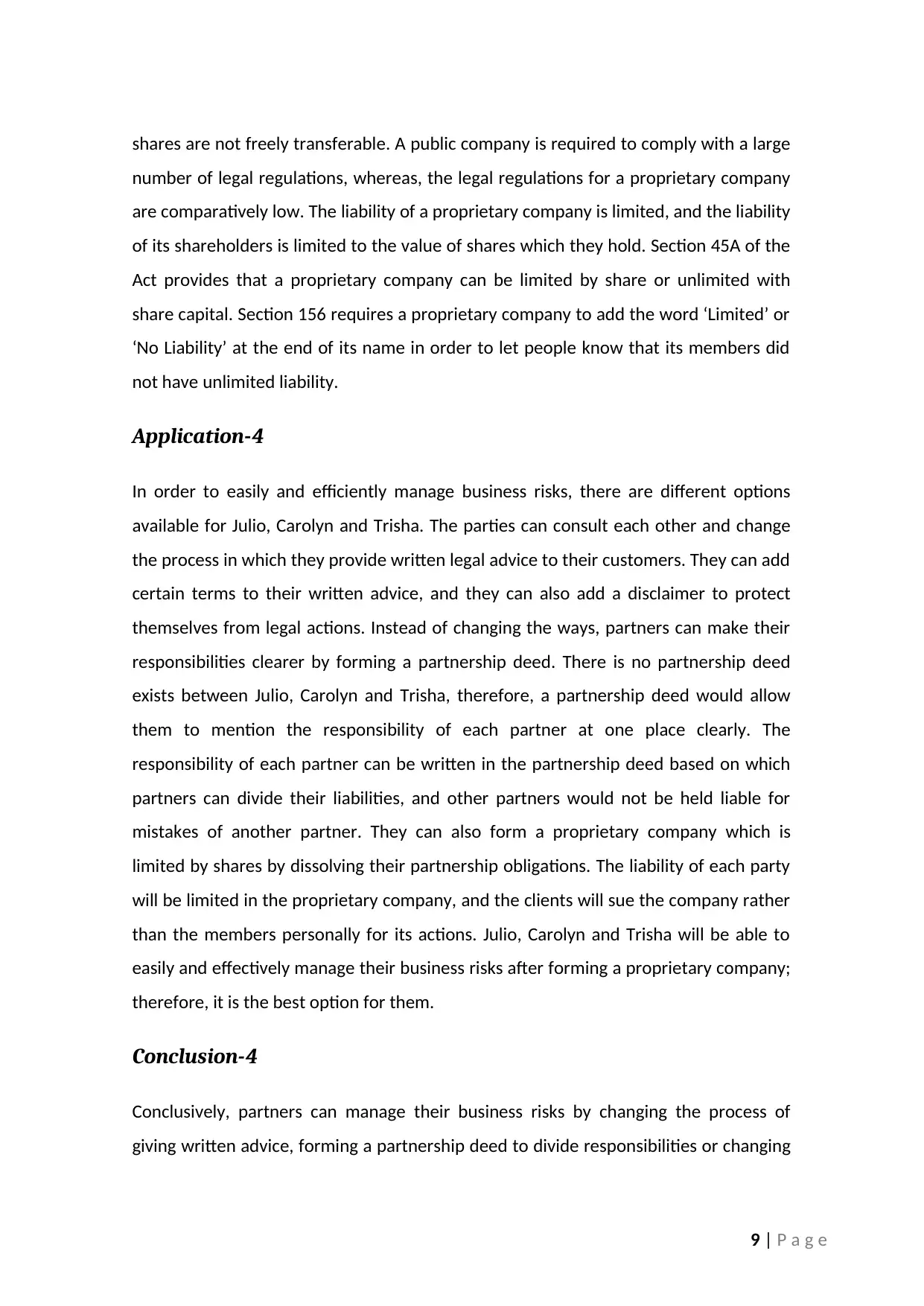
shares are not freely transferable. A public company is required to comply with a large
number of legal regulations, whereas, the legal regulations for a proprietary company
are comparatively low. The liability of a proprietary company is limited, and the liability
of its shareholders is limited to the value of shares which they hold. Section 45A of the
Act provides that a proprietary company can be limited by share or unlimited with
share capital. Section 156 requires a proprietary company to add the word ‘Limited’ or
‘No Liability’ at the end of its name in order to let people know that its members did
not have unlimited liability.
Application-4
In order to easily and efficiently manage business risks, there are different options
available for Julio, Carolyn and Trisha. The parties can consult each other and change
the process in which they provide written legal advice to their customers. They can add
certain terms to their written advice, and they can also add a disclaimer to protect
themselves from legal actions. Instead of changing the ways, partners can make their
responsibilities clearer by forming a partnership deed. There is no partnership deed
exists between Julio, Carolyn and Trisha, therefore, a partnership deed would allow
them to mention the responsibility of each partner at one place clearly. The
responsibility of each partner can be written in the partnership deed based on which
partners can divide their liabilities, and other partners would not be held liable for
mistakes of another partner. They can also form a proprietary company which is
limited by shares by dissolving their partnership obligations. The liability of each party
will be limited in the proprietary company, and the clients will sue the company rather
than the members personally for its actions. Julio, Carolyn and Trisha will be able to
easily and effectively manage their business risks after forming a proprietary company;
therefore, it is the best option for them.
Conclusion-4
Conclusively, partners can manage their business risks by changing the process of
giving written advice, forming a partnership deed to divide responsibilities or changing
9 | P a g e
number of legal regulations, whereas, the legal regulations for a proprietary company
are comparatively low. The liability of a proprietary company is limited, and the liability
of its shareholders is limited to the value of shares which they hold. Section 45A of the
Act provides that a proprietary company can be limited by share or unlimited with
share capital. Section 156 requires a proprietary company to add the word ‘Limited’ or
‘No Liability’ at the end of its name in order to let people know that its members did
not have unlimited liability.
Application-4
In order to easily and efficiently manage business risks, there are different options
available for Julio, Carolyn and Trisha. The parties can consult each other and change
the process in which they provide written legal advice to their customers. They can add
certain terms to their written advice, and they can also add a disclaimer to protect
themselves from legal actions. Instead of changing the ways, partners can make their
responsibilities clearer by forming a partnership deed. There is no partnership deed
exists between Julio, Carolyn and Trisha, therefore, a partnership deed would allow
them to mention the responsibility of each partner at one place clearly. The
responsibility of each partner can be written in the partnership deed based on which
partners can divide their liabilities, and other partners would not be held liable for
mistakes of another partner. They can also form a proprietary company which is
limited by shares by dissolving their partnership obligations. The liability of each party
will be limited in the proprietary company, and the clients will sue the company rather
than the members personally for its actions. Julio, Carolyn and Trisha will be able to
easily and effectively manage their business risks after forming a proprietary company;
therefore, it is the best option for them.
Conclusion-4
Conclusively, partners can manage their business risks by changing the process of
giving written advice, forming a partnership deed to divide responsibilities or changing
9 | P a g e
Paraphrase This Document
Need a fresh take? Get an instant paraphrase of this document with our AI Paraphraser
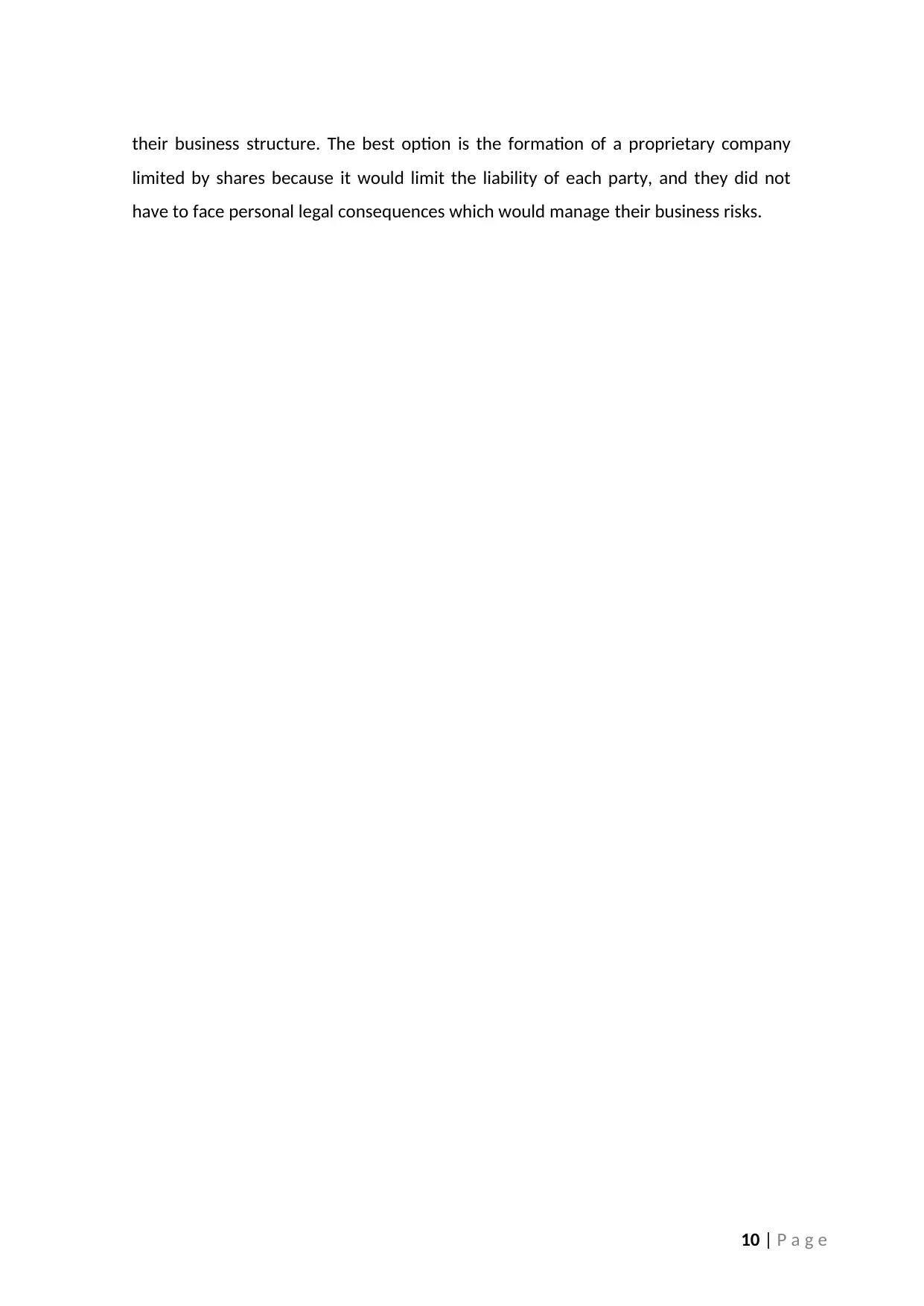
their business structure. The best option is the formation of a proprietary company
limited by shares because it would limit the liability of each party, and they did not
have to face personal legal consequences which would manage their business risks.
10 | P a g e
limited by shares because it would limit the liability of each party, and they did not
have to face personal legal consequences which would manage their business risks.
10 | P a g e
1 out of 11
Related Documents
Your All-in-One AI-Powered Toolkit for Academic Success.
+13062052269
info@desklib.com
Available 24*7 on WhatsApp / Email
![[object Object]](/_next/static/media/star-bottom.7253800d.svg)
Unlock your academic potential
Copyright © 2020–2025 A2Z Services. All Rights Reserved. Developed and managed by ZUCOL.





